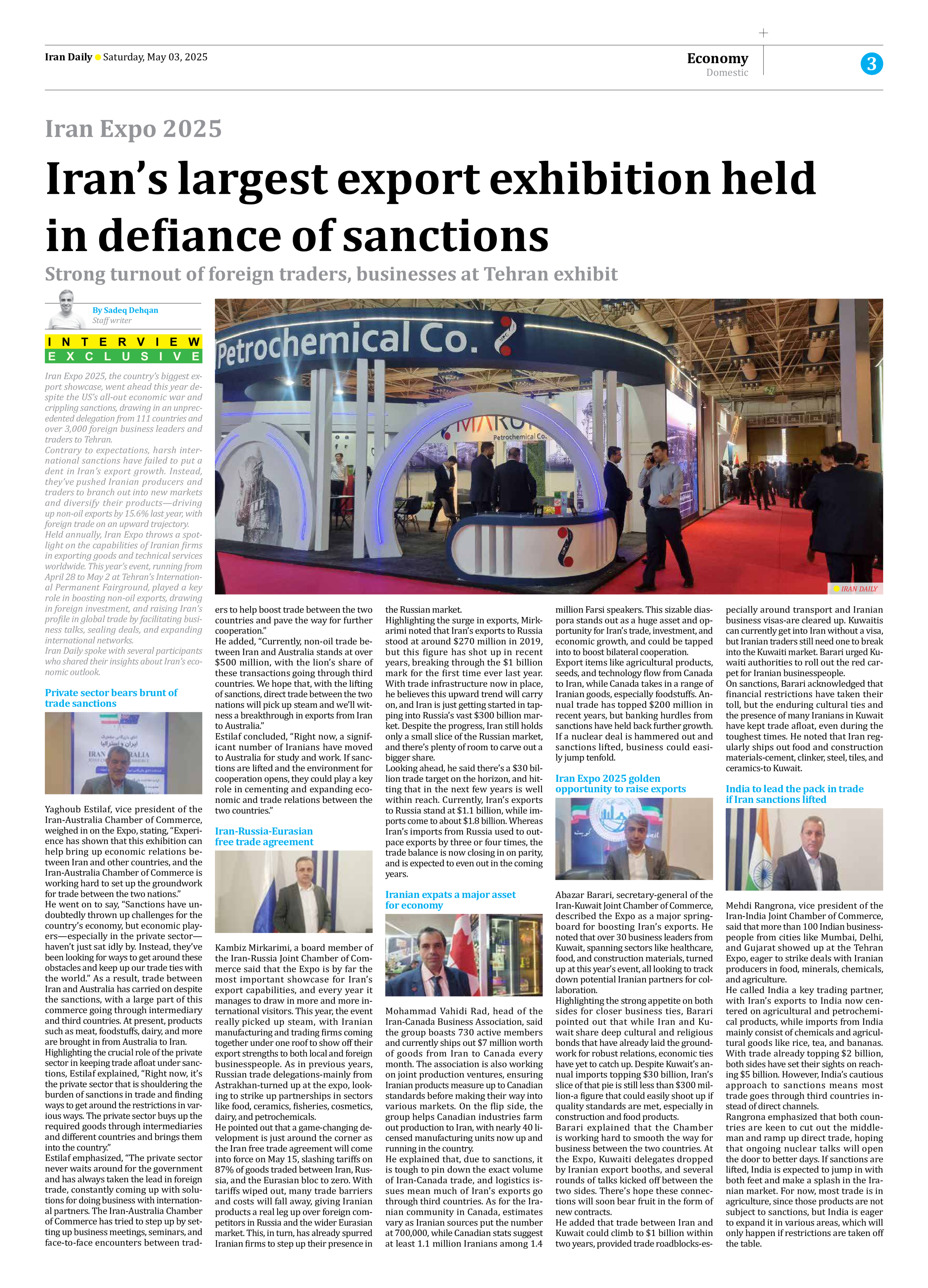
Iran Expo 2025
Iran’s largest export exhibition held in defiance of sanctions
Strong turnout of foreign traders, businesses at Tehran exhibit
By Sadeq Dehqan
Staff writer
Iran Expo 2025, the country’s biggest export showcase, went ahead this year despite the US’s all-out economic war and crippling sanctions, drawing in an unprecedented delegation from 111 countries and over 3,000 foreign business leaders and traders to Tehran.
Contrary to expectations, harsh international sanctions have failed to put a dent in Iran’s export growth. Instead, they’ve pushed Iranian producers and traders to branch out into new markets and diversify their products—driving up non-oil exports by 15.6% last year, with foreign trade on an upward trajectory.
Held annually, Iran Expo throws a spotlight on the capabilities of Iranian firms in exporting goods and technical services worldwide. This year’s event, running from April 28 to May 2 at Tehran’s International Permanent Fairground, played a key role in boosting non-oil exports, drawing in foreign investment, and raising Iran’s profile in global trade by facilitating business talks, sealing deals, and expanding international networks.
Iran Daily spoke with several participants who shared their insights about Iran’s economic outlook.
Private sector bears brunt of trade sanctions
Yaghoub Estilaf, vice president of the Iran-Australia Chamber of Commerce, weighed in on the Expo, stating, “Experience has shown that this exhibition can help bring up economic relations between Iran and other countries, and the Iran-Australia Chamber of Commerce is working hard to set up the groundwork for trade between the two nations.”
He went on to say, “Sanctions have undoubtedly thrown up challenges for the country’s economy, but economic players—especially in the private sector—haven’t just sat idly by. Instead, they’ve been looking for ways to get around these obstacles and keep up our trade ties with the world.” As a result, trade between Iran and Australia has carried on despite the sanctions, with a large part of this commerce going through intermediary and third countries. At present, products such as meat, foodstuffs, dairy, and more are brought in from Australia to Iran.
Highlighting the crucial role of the private sector in keeping trade afloat under sanctions, Estilaf explained, “Right now, it’s the private sector that is shouldering the burden of sanctions in trade and finding ways to get around the restrictions in various ways. The private sector buys up the required goods through intermediaries and different countries and brings them into the country.”
Estilaf emphasized, “The private sector never waits around for the government and has always taken the lead in foreign trade, constantly coming up with solutions for doing business with international partners. The Iran-Australia Chamber of Commerce has tried to step up by setting up business meetings, seminars, and face-to-face encounters between traders to help boost trade between the two countries and pave the way for further cooperation.”
He added, “Currently, non-oil trade between Iran and Australia stands at over $500 million, with the lion’s share of these transactions going through third countries. We hope that, with the lifting of sanctions, direct trade between the two nations will pick up steam and we’ll witness a breakthrough in exports from Iran to Australia.”
Estilaf concluded, “Right now, a significant number of Iranians have moved to Australia for study and work. If sanctions are lifted and the environment for cooperation opens, they could play a key role in cementing and expanding economic and trade relations between the two countries.”
Iran-Russia-Eurasian
free trade agreement
Kambiz Mirkarimi, a board member of the Iran-Russia Joint Chamber of Commerce said that the Expo is by far the most important showcase for Iran’s export capabilities, and every year it manages to draw in more and more international visitors. This year, the event really picked up steam, with Iranian manufacturing and trading firms coming together under one roof to show off their export strengths to both local and foreign businesspeople. As in previous years, Russian trade delegations-mainly from Astrakhan-turned up at the expo, looking to strike up partnerships in sectors like food, ceramics, fisheries, cosmetics, dairy, and petrochemicals.
He pointed out that a game-changing development is just around the corner as the Iran free trade agreement will come into force on May 15, slashing tariffs on 87% of goods traded between Iran, Russia, and the Eurasian bloc to zero. With tariffs wiped out, many trade barriers and costs will fall away, giving Iranian products a real leg up over foreign competitors in Russia and the wider Eurasian market. This, in turn, has already spurred Iranian firms to step up their presence in the Russian market.
Highlighting the surge in exports, Mirkarimi noted that Iran’s exports to Russia stood at around $270 million in 2019, but this figure has shot up in recent years, breaking through the $1 billion mark for the first time ever last year. With trade infrastructure now in place, he believes this upward trend will carry on, and Iran is just getting started in tapping into Russia’s vast $300 billion market. Despite the progress, Iran still holds only a small slice of the Russian market, and there’s plenty of room to carve out a bigger share.
Looking ahead, he said there’s a $30 billion trade target on the horizon, and hitting that in the next few years is well within reach. Currently, Iran’s exports to Russia stand at $1.1 billion, while imports come to about $1.8 billion. Whereas Iran’s imports from Russia used to outpace exports by three or four times, the trade balance is now closing in on parity, and is expected to even out in the coming years.
Iranian expats a major asset
for economy
Mohammad Vahidi Rad, head of the Iran-Canada Business Association, said the group boasts 730 active members and currently ships out $7 million worth of goods from Iran to Canada every month. The association is also working on joint production ventures, ensuring Iranian products measure up to Canadian standards before making their way into various markets. On the flip side, the group helps Canadian industries farm out production to Iran, with nearly 40 licensed manufacturing units now up and running in the country.
He explained that, due to sanctions, it is tough to pin down the exact volume of Iran-Canada trade, and logistics issues mean much of Iran’s exports go through third countries. As for the Iranian community in Canada, estimates vary as Iranian sources put the number at 700,000, while Canadian stats suggest at least 1.1 million Iranians among 1.4 million Farsi speakers. This sizable diaspora stands out as a huge asset and opportunity for Iran’s trade, investment, and economic growth, and could be tapped into to boost bilateral cooperation.
Export items like agricultural products, seeds, and technology flow from Canada to Iran, while Canada takes in a range of Iranian goods, especially foodstuffs. Annual trade has topped $200 million in recent years, but banking hurdles from sanctions have held back further growth. If a nuclear deal is hammered out and sanctions lifted, business could easily jump tenfold.
Iran Expo 2025 golden opportunity to raise exports
Abazar Barari, secretary-general of the Iran-Kuwait Joint Chamber of Commerce, described the Expo as a major springboard for boosting Iran’s exports. He noted that over 30 business leaders from Kuwait, spanning sectors like healthcare, food, and construction materials, turned up at this year’s event, all looking to track down potential Iranian partners for collaboration.
Highlighting the strong appetite on both sides for closer business ties, Barari pointed out that while Iran and Kuwait share deep cultural and religious bonds that have already laid the groundwork for robust relations, economic ties have yet to catch up. Despite Kuwait’s annual imports topping $30 billion, Iran’s slice of that pie is still less than $300 million-a figure that could easily shoot up if quality standards are met, especially in construction and food products.
Barari explained that the Chamber is working hard to smooth the way for business between the two countries. At the Expo, Kuwaiti delegates dropped by Iranian export booths, and several rounds of talks kicked off between the two sides. There’s hope these connections will soon bear fruit in the form of new contracts.
He added that trade between Iran and Kuwait could climb to $1 billion within two years, provided trade roadblocks-especially around transport and Iranian business visas-are cleared up. Kuwaitis can currently get into Iran without a visa, but Iranian traders still need one to break into the Kuwaiti market. Barari urged Kuwaiti authorities to roll out the red carpet for Iranian businesspeople.
On sanctions, Barari acknowledged that financial restrictions have taken their toll, but the enduring cultural ties and the presence of many Iranians in Kuwait have kept trade afloat, even during the toughest times. He noted that Iran regularly ships out food and construction materials-cement, clinker, steel, tiles, and ceramics-to Kuwait.
India to lead the pack in trade
if Iran sanctions lifted
Mehdi Rangrona, vice president of the Iran-India Joint Chamber of Commerce, said that more than 100 Indian businesspeople from cities like Mumbai, Delhi, and Gujarat showed up at the Tehran Expo, eager to strike deals with Iranian producers in food, minerals, chemicals, and agriculture.
He called India a key trading partner, with Iran’s exports to India now centered on agricultural and petrochemical products, while imports from India mainly consist of chemicals and agricultural goods like rice, tea, and bananas. With trade already topping $2 billion, both sides have set their sights on reaching $5 billion. However, India’s cautious approach to sanctions means most trade goes through third countries instead of direct channels.
Rangrona emphasized that both countries are keen to cut out the middleman and ramp up direct trade, hoping that ongoing nuclear talks will open the door to better days. If sanctions are lifted, India is expected to jump in with both feet and make a splash in the Iranian market. For now, most trade is in agriculture, since those products are not subject to sanctions, but India is eager to expand it in various areas, which will only happen if restrictions are taken off the table.







